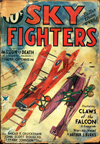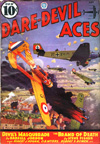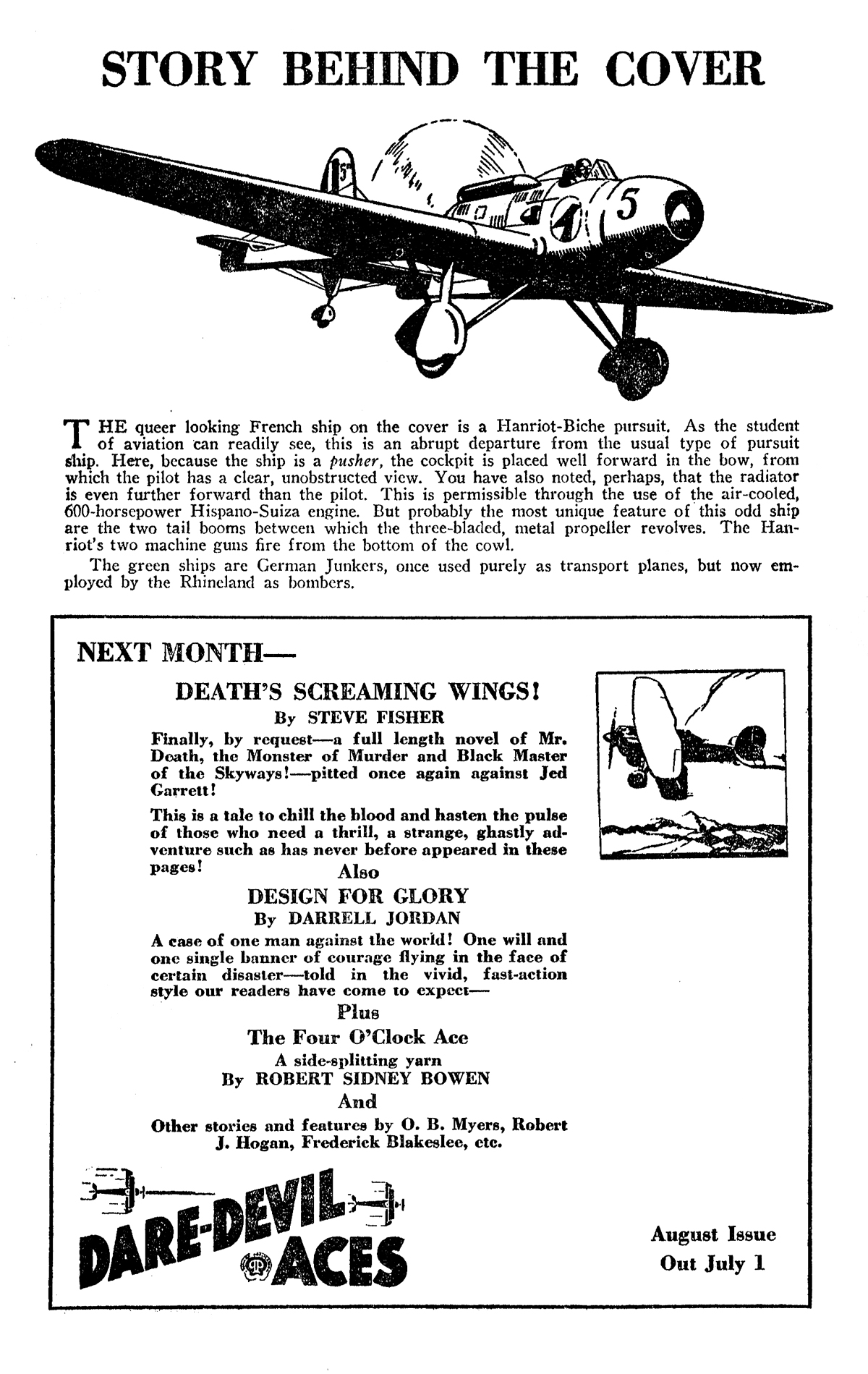Eugene M. Frandzen painted the covers of Sky Fighters from its first issue in 1932 until he moved on from the pulps in 1939. At this point in the run, the covers were about the planes featured on the cover more than the story depicted. On the May 1934 cover, Frandzen featured the German Junkers and D.H.4!
ON THE cover this month  you will find the German Junkers biplane and the American Liberty-motored D.H.4. The D.H.4 was our one and only contribution to the front. That plane took nearly a year to produce.
you will find the German Junkers biplane and the American Liberty-motored D.H.4. The D.H.4 was our one and only contribution to the front. That plane took nearly a year to produce.
It was designed after the famous British D.H., which earlier in the war; could stand up to any of the enemy planes. But the war moved fast. The Germans and the Allies changed and improved their planes so often that it was hard for this country to keep up with the advancement made on the other side of the pond.

A Difficult Task
We sent over commissions to nose around and pick out a few types of planes which could be put into mass production in this country, built around the bulky twelve-cylinder Liberty motor.
It took the boys on the commission several weeks to make up their minds as to which of the Allies* planes could be copied and be satisfactory. When they finally got back to Washington and got the designers busy it took three weeks of night and day work for them to complete their work.
They Were Obsolete
Just as the duplicate sets of plana were ready to go to the manufacturers word came from abroad that the planes the Americans planned to build were obsolete. Another commission hopped the ferry for Europe and went through the same stunt.
Again the designs were drawn; again they were pitched over because they were out-dated. Finally, after nearly a year of discouraging experimenting and disappointments the cumbersome American D. H. 4 started to roll off on the production line in an endless stream. In the first quarter of 1918 the first shipments were delivered to the Yanks at the front. They took ‘em, gritted their teeth and did what they could with a type of ship which the British had abandoned as obsolete some months before.
There were 23,000 screws holding that old D.H. crate of ours together, also 600 separate pieces of wood in a single wing; possibly that’s one of the reasons that delayed the boys back home from delivering the planes before they were listed in the antique class.
Well, the pilot and observer in the D.H. on the cover got a break when they got in a scrap with the German Junkers biplane. It was also a crate of earlier vintage, but a good one. The Junkers outfit was associated with the Fokker Company. This thick-winged job shows the Fokker influence.
The Fight Is On!
Returning from a reconnaissance expedition the D.H. ran across the Junkers. Both pilots decided that he could outsmart the other; the fight was on. The planes, evenly matched, tore in at each other like a couple of hungry wolves, ripped bullets through each other’s wings and squared off for another round. Again and again they tangled.

The D.H. was getting the worst of it. Suddenly a Fokker D.7 comes in from the distance. The Yank gunner spots it, points it out to his pilot. But a passing Frenchman in a Spad sees the set up and kicks his fleet plane into the show. He is in a position to pop the Fokker down. The Junkers zooms up under the D.H.’s tail.
It Looks Like Curtains
It looks like curtains for the Americans. The Yank pilot flips his tail down. The German tries to miss a collision. He succeeds, but the tip of his propeller blade grazes the aft part of the D.H.’s fuselage; just barely touches it, but that is all that is necessary.
Bingo, his prop flies to pieces. He is gone, through, licked. And the D.H., with its 23,000 screws, shakes its ruffled tail feathers and sails proudly for home—victorious.

Sky Fighters, ,June 1934 by Eugene M. Frandzen
(The Ships on The Cover Page)
 THE queer looking French ship on the cover is a Hanriot-Biche pursuit. As the student of aviation can readily see, this is an abrupt departure from the usual type of pursuit ship. Here, because the ship is a pusher, the cockpit is placed well forward in the bow, from which the pilot has a clear, unobstructed view. You have also noted, perhaps, that the radiator is even further forward than the pilot. This is permissible through the use of the air-cooled, 600-horsepower Hispano-Suiza engine. But probably the most unique feature of this odd ship are the two tail booms between which the three-bladed, metal propeller revolves. The Hanriot’s two machine guns fire from the bottom of the cowl.
THE queer looking French ship on the cover is a Hanriot-Biche pursuit. As the student of aviation can readily see, this is an abrupt departure from the usual type of pursuit ship. Here, because the ship is a pusher, the cockpit is placed well forward in the bow, from which the pilot has a clear, unobstructed view. You have also noted, perhaps, that the radiator is even further forward than the pilot. This is permissible through the use of the air-cooled, 600-horsepower Hispano-Suiza engine. But probably the most unique feature of this odd ship are the two tail booms between which the three-bladed, metal propeller revolves. The Hanriot’s two machine guns fire from the bottom of the cowl.








